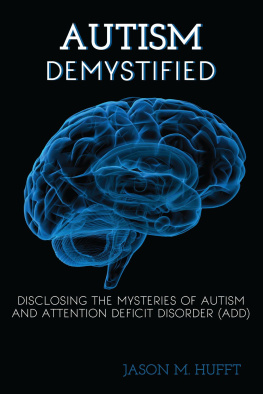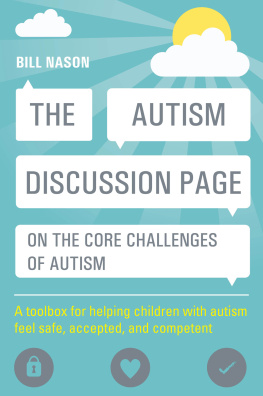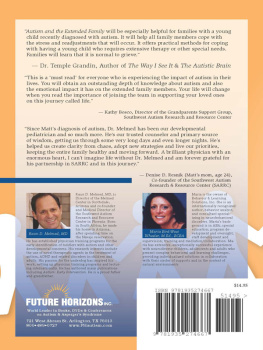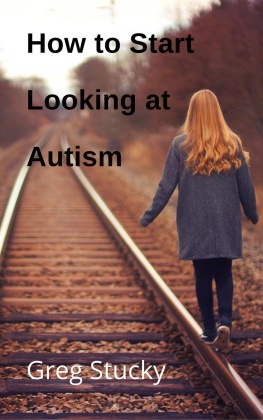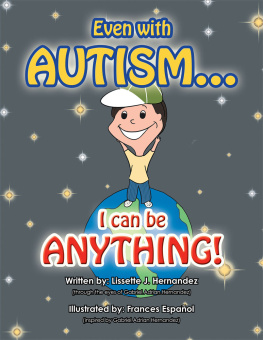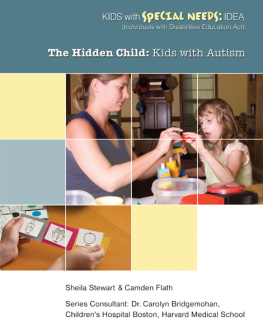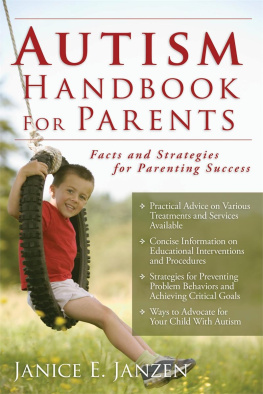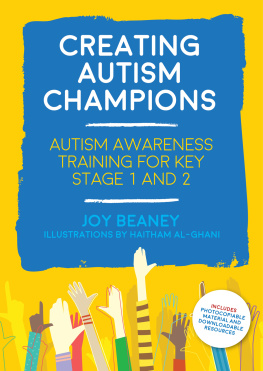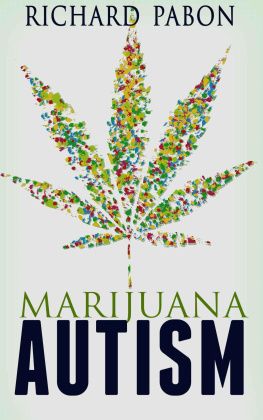Table of Contents

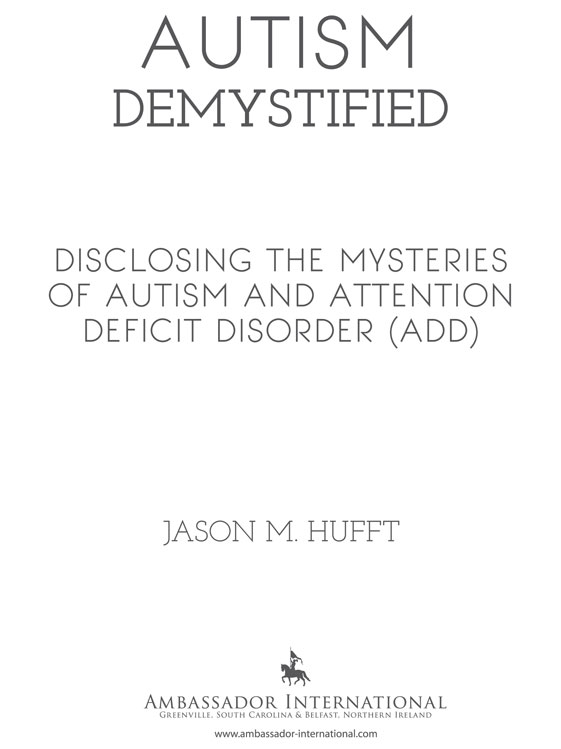
Autism Demystified
Disclosing the Mysteries of Autism and Attention Deficit Disorder (ADD)
2014 by Jason M. Hufft
All rights reserved
ISBN: 978-1-62020-277-7
eISBN: 978-1-62020-380-4
Disclaimer: The contents of this book are not a substitute to professional assessment or treatment of mental or emotional disorders. Rather it is a forestep aiding the individual in self-identification of the effects of personal choice in contributing to their present life situation. It assumes that each individual is capable of making life-enhancing decisions.
Cover Design & Page Layout by Hannah Nichols
Ebook Conversion by Anna Riebe
AMBASSADOR INTERNATIONAL
Emerald House
427 Wade Hampton Blvd.
Greenville, SC 29609, USA
www.ambassador-international.com
AMBASSADOR BOOKS
The Mount
2 Woodstock Link
Belfast, BT6 8DD, Northern Ireland, UK
www.ambassador-international.com
The colophon is a trademark of Ambassador
DEDICATIONS
To Jesus Christ, our God and heavenly father who provides us with our knowledge, wisdom, and unique abilities;
To my parents and family who have always supported and encouraged me;
To my co-workers who dedicate their lives to serving and caring for children;
To my students with special needs who have provided me a wealth of knowledge I now share with others;
To all children who suffer from autism, attention deficit disorder, or related birth boundary who wish to discover more about themselves and their conditions.
ACKNOWLEDGMENTS
Writing a book reminds me of building a puzzle: the only difference is I did not have the pieces. It is a daunting responsibility to design and create those pieces as well as decide how to put them together. I prayed every evening for guidance to write this book, and asked for words of wisdom to share with readers. As a result, I never failed to find ideas or the right words to share.
Thus, I give a multitude of thanks to the Lord. I thank Him, for He is the ultimate source of truth. It is only through Him I had the ability and knowledge to perform the duties He has set before me: to take care of children with special needs. I thank Him and accept my duty and calling.
I also thank my parents for the wonderful job they have done to prepare me for the life the Lord has given me and the earthly job He has assigned to me. So many caregivers break connection with their children when they reach adulthood and fail to recognize the significance of their presence in their childrens lives. Again, thank you for your continued support and guidance you have so willingly given me throughout the years, especially during the creation of this work.
To my very close friend, Kevin McCarthy, author of Surviving the Justice Experience and founder of a nonprofit organization that provides spiritual guidance and support to families of criminal offenders, I extend another multitude of thanks. Your continuous support and feedback regarding my ideas and feelings throughout the creation of this work is greatly appreciated.
I also thank my co-workers for their support and the information they provided me. While working in many teachers classrooms, I have become aware of many struggles faced by teachers and caregivers who service children with autism and other related conditions. Thank you for allowing me the opportunity to observe children in classroom environments as well as record my observation data while working with them.
Thank you to my remaining family members and friends who provided me a wealth of support during this project. Although I cannot list every name, this work would not be as successful and productive as it is without your support.
Finally, I thank all of my students as well as the many children I have worked with over the years. I hope one day you will read this work and recognize the unique part you played in its development. In particular, I thank the caregivers who shared their childrens stories with me and trusted my support outside of the school system. Your generosity allowed me to share the truth about the struggles many children face with developmental deficiencies.
INTRODUCTION
Values and moral standards have progressively faded away in the lives of children. No longer is a thank you given for a generous offering or hospitality. Rather than acknowledge gracious intentions, a complaint is made regarding the quality or quantity of a gift. It has become normal, learned behavior.
Unfortunately, people assume children behave with little or no moral standards because it has become more difficult to identify a child with a decent, loving, and accepting heart when he or she is presented an offering. Basically, rude childrenonce considered the minorityhave become the majority.
When children do not learn to express appreciation when another person offers a helping hand, or thoughtful gesture, inappropriate behavior is viewed as a proper response. Rather than learn appropriate conduct, unsuitable behavior takes root because it is the understood way to function in society. When no one identifies or confronts problematic behavior, it remains a problem and a disproportionate number of uncivilized individuals evolve. As a result, replacement behavior is never learned.
Problem behavior is identifiable when a comparison is made between individuals in a majority group who exhibit similar behavioral characteristics and individuals in a minority group who exhibit opposing behavioral characteristics. In other words, there must be a marked difference in behavioral characteristics in order to recognize problem behavior.
We generally assume the majority group as the norm. This might be true when we first consider the behavior of children because we use these observations to make certain judgments, which affect their lives. Suppose, however, the minority group became the majority groupabnormal, undesirable behavior became the norm.
Then society begins to assume inappropriate behavior is typical of children because it is exhibited by a majority group. If the minority group is always assumed to be abnormal, the group actually exhibiting problem behavior is overlooked. The problem is no longer identifiable; therefore, society begins to accept problem behavior or fails to recognize it. Then, blame is placed based on assumption.
For example, blame is placed on teaching practices, the use of video games, a childs diet, and many other sources with no connection to the true cause of autism, attention deficit disorder (ADD), and other related birth boundaries. This is exactly what has transpired with populations of children with special needs, including autism and ADD.
In a typical classroom at least 25 percent of students suffer from autism, ADD, or related autism spectrum disorders: five out of twenty students. This percentage is a generous estimate because in many classrooms, 50 percent of students suffer some level of autism spectrum disorder. In other classrooms, even more. Grade levels in schools struggle to manage children in large gatherings (i.e., practices for school plays) because they exhibit uncontrollable behaviors.
The uneducated have accepted these behaviors as the normal, typical childhood behavior, and autism and ADD are often overlooked. Basically, because autism and ADD behavior increasingly flood our society and local schools, those behaviors have become the conduct of a majority group. The behavior of a typical child has become the minority.

